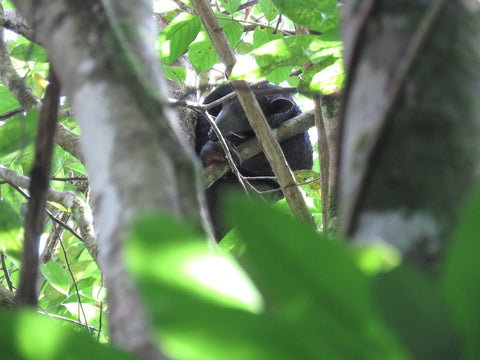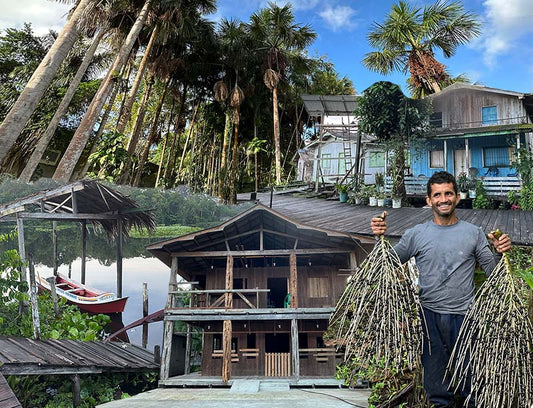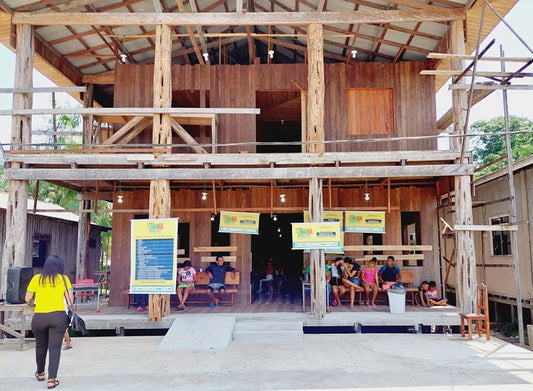As a company that was born in the Amazon Rainforest of South America, our minds are often concerned for the well-being of its inhabitants. As the most biologically diverse place on Earth, it's home to millions of different species, many of which are under threat due to deforestation and climate change. In 2020, we sponsored a biodiversity study to measure and document the incredible wildlife and species that exist in the area where we harvest our Açaí in Brazil. Curious to know more about the animals of the Amazon that we discovered were helping to protect along the way?

The Amazon Rainforest
As the world's most iconic tropical rainforest, the Amazon spans 1.4 billion acres across 9 countries, supports 10% of the world's biodiversity and is one of Earth's largest carbon stores - the ocean is #1. This landscape is under imminent threat, with over 20% of the region already destroyed, primarily from slash-and-burn agricultural practices. Luckily, there are organizations like the Rainforest Trust Foundation that are working to conserve and protect these different species with their Conservation Action Fund, which established public and private nature reserves managed by local conservation partners.
This is where our desire to sponsor a research grant measuring our impact on the Amazon Rainforest ecosystem was sparked. The Biodiversity Study, spearheaded by Dr. Gabriel Damasco, Ph.D. from UC Berkeley, was published in January of 2022, and found that the certification of Açaí agroforestry improved the conservation of the Amazonian tree flora. Although the focus of this study was on the tree species in this region, we did discover some rather interesting details on the diversity of the Amazon Rainforest animals that co-exist in our certified harvesting areas...
How did we study the animals in our certified harvesting areas?
Field rainforest expeditions were performed and the research plots were established near different villages where certified Açaí harvesting for SAMBAZON occurs. If you've ever wondered, "Where does Açaí come from?" well, there's your answer. One of these locations was in the Bailique Archipelago region. The name “Bailique” locally means “dancing islands” and the name is due to the fluvial dynamism caused by string tides in the Amazon River’s mouth, that constantly reshape the size of the islands. Imagine your home constantly changing shape!

Birds, mammals, amphibians and reptiles were sampled with observations, scat, sign, tracks, vocalizations, and camera trap methods. The bird survey was done through observations starting at sunrise, around 5:30 a.m. to 12:00 p.m., and from 3:00 p.m. to 5:00 p.m. The best way to count birds is when they are leaving and come home to their night roosts. Whenever possible, individuals were recorded and photographed. The sampling corresponds to very silent and slow walking, looking carefully for animals on litter, tree trunks, dead trunks, soil, under tree barks, termite nests, and other typical shelters usually used by other animals. It is a bit like the slowest, most intense nature walk you can imagine! All the individual animals were identified to the animal species level by taxonomic experts.

Over the course of three days, cameras with moving sensors were installed to track mammals. We would never leave out our pollinator communities, they are part of what makes Açaí possible! These were sampled by using GoPro cameras placed on top of Açaí palm trees to record the insect community that visits the Açaí flowers.
What did the research find about species in our certified harvesting areas?
Our certified harvesting sites have lots of plants and animals! Many are common and widespread species but they also found dense animal populations of threatened species thriving among our Açaí palms. Among the birds, the main dispersers of Açaí seeds are sabiás, representatives of the genus Turdus, the toucans and araçaris (Ramphastos toco, Ramphastostou cans, Ramphastos vitellinus, Pteroglossus aracari), surucua (Trogon viridis) and anambé-pigeon (Gymnoderus foetidus) - it was great to see them all in such abundance. Who doesn't love to see a toucan? Small rodents are very associated with the dispersion of Açaí fruits, as well as species of primates and other medium mammals such as agoutis, coatis, and get to represent 80% of their diet. These were all found thriving in the Açaí forest as well.
When asked what animals they found most intriguing in their study, Dr. Damasco explained: "We registered three threatened bird species based on the IUCN updated list: the festive Amazon (Amazona festive) and the gray hatchback (Thamnophilus nigrocinereus), and the Tucano-de-white-throat (Ramphastos tucanus), all endemic to the Amazon region.

"We photographed using our camera traps a rare anteater that looks very similar to a newly, but not yet described, species from the area. Also, we found a jaguar track in the second expedition. We set the camera trap in that same trail for many days but unfortunately, the never returned." It would have been great to get a picture of the elusive jaguar, but with a home range of hundreds of kilometers for a single jaguar, a footprint is good enough to let us know they are still there.
Our Friends in the Amazon
Explore and learn more about some of the amazing Amazon Rainforest animals that the researchers found in our harvesting areas:

Tamandua Tetradactyla, Southern Tamandua (Collared anteater)
Average Life Span: 9 years
Size: 13-35 inches long, prehensile tail 15 to 26 inches long
Fun Fact: The southern tamandua spends the majority of their time in trees, and has powerful forearms for self-defense. In combat, it will grasp a branch with its hind-feet and tail, leaving its arms and long, curved claws free for combat. Their predators include pumas, cougars, jaguars, eagles, and snakes.

Coati, Nasua nasua (Ringtailed coati)
Average Life Span: 7 years
Size: 26 inches long, about the size of a house cat
Fun Fact: The coati is adaptable to live across a wide variety of habitats because it can eat almost anything discovered in leaf litter: leaves, fruit, insects, tarantulas, birds, lizards, snakes, rodents, and even crocodile eggs. Their predators include snakes like the green anaconda, jaguars, pumas, crocodiles, and jaguarundis.

Garça-branca-pequena, Egretta thula (Snowy Egret)
Average Life Span: 22 years
Size: 22 to 25 inches tall, 40 inch wingspan
Fun Fact: Snowy egrets stalk prey in shallow water by running or shuffling their feet, flushing prey into view by swaying their heads, flicking their wings or vibrating their bills. Their predators include owls, hawks, and snakes like the green anaconda.

Ninho de araracanga, Ara macao (Scarlet Macaw)
Average Life Span: In the Wild - 40 to 50 years
Size: 35 inches, tail includes 1/3 - 1/2 of this
Fun Fact: Scarlet macaws are known to consumer fruits before they are ripe, which can include harsh chemicals such as tannins that are toxic to other animals. They are able to ingest these premature fruits because of the digestion aid provided by clay they consume on the banks of rivers. Their predators include the harpy eagle, jaguars, hawks, monkeys, and snakes.

Chatogekko amazonicus, Brazilian pygmy gecko
Size: 0.94-inch maximum length including tail
Fun Fact: The gecko's skin is highly hydrophobic, to the degree that they are able to avoid drowning in rainstorms on the forest floor despite their small size, and even float on water. Their predators include birds like the scarlet macaw and harpy eagle, snakes, and spiders like the Brazilian wandering spider.
Looking Forward
SAMBAZON will continue to protect the richness and diversity of the Amazon environment that we utilize to bring you the Delicious Powers of Açaí by pursuing certified sustainable practices in our Açaí products. Dr. Damasco sums it up quite nicely: “We are urged to find a more integrative way to effectively protect the biodiversity in the Amazon. Our society, industry, and government need to work jointly and solve it together. As exemplified in our study, certified Açaí agroforestry may provide many environmental and social benefits. It can improve livelihoods for residents, promote conservation of forests that harbor high biodiversity, and prevent unregulated deforestation that, in turn, exacerbates global climate change.”
At SAMBAZON, we're always learning how to be more eco-friendly with our Açaí products to contribute to a better environment on earth for all of its inhabitants, including the many amazing animals of the Amazon. We are committed to achieving plant-based and post-consumer recycled packaging for all USA retail products by 2025. Discover the powers of Açaí today.
Sources
Damasco, G., Anhalt, M., Perdiz, R.O. et al. Certification of açaí agroforestry increases the conservation potential of the Amazonian tree flora. Agroforest Syst 96, 407–416 (2022). https://doi.org/10.1007/s10457-021-00727-2
Rainforest Trust Foundation. Save the Amazon. https://www.rainforesttrust.org/save-the-amazon/
Gorog, A. 1999. "Tamandua tetradactyla" (On-line), Animal Diversity Web. https://animaldiversity.org/accounts/Tamandua_tetradactyla/
National Geographic. Coatis. https://www.nationalgeographic.com/animals/mammals/facts/coatis
Anamilia. Snowy Egret. https://animalia.bio/snowy-egret
Mijal, M. 2001. "Ara macao" (On-line), Animal Diversity Web. https://animaldiversity.org/accounts/Ara_macao/
Brazilian pygmy gecko. https://en.wikipedia.org/wiki/Brazilian_pygmy_gecko







Comments
(0 Comments)Please note, comments need to be approved before they are published.